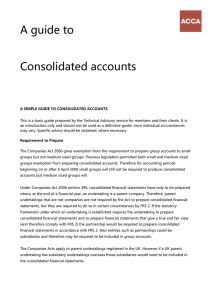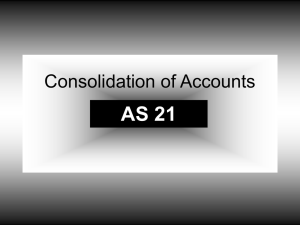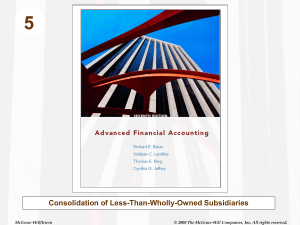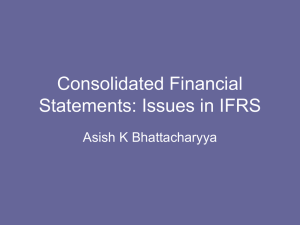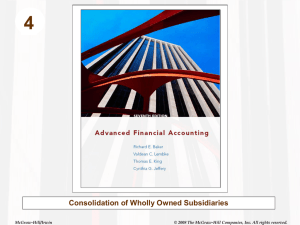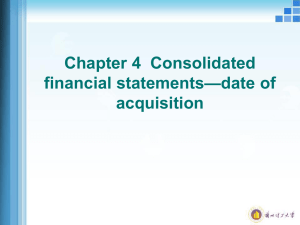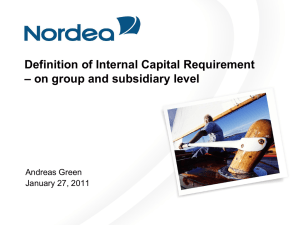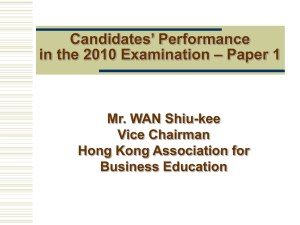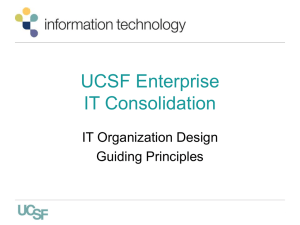Guide to...consolidated accounts for business
advertisement
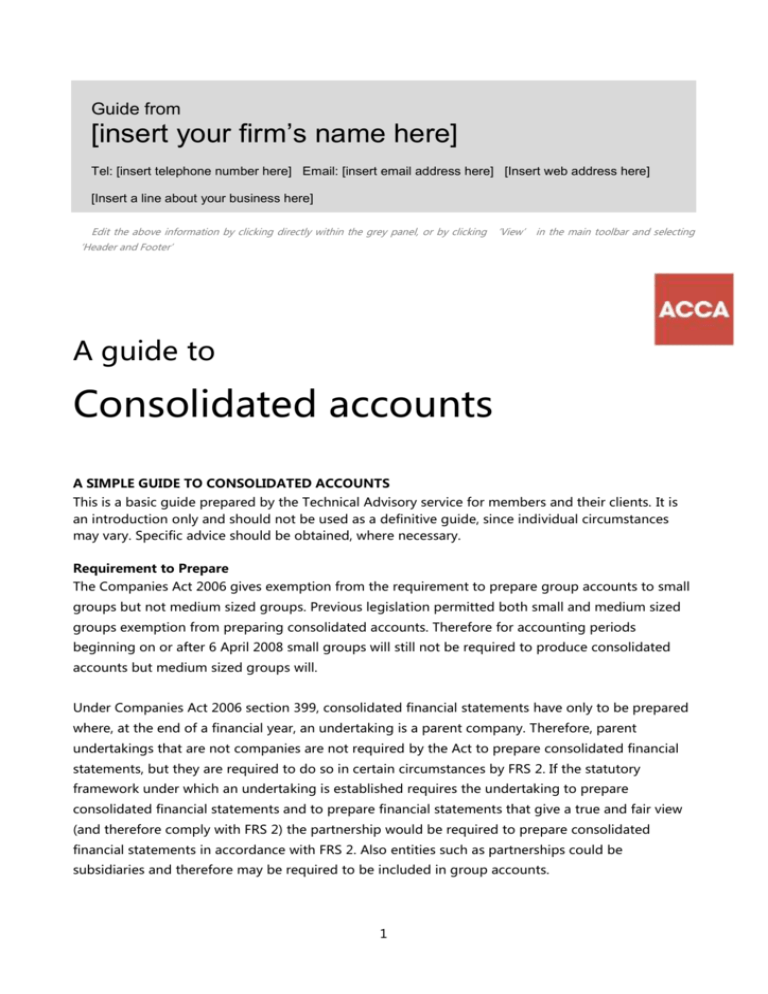
Guide from [insert your firm’s name here] Tel: [insert telephone number here] Email: [insert email address here] [Insert web address here] [Insert a line about your business here] Edit the above information by clicking directly within the grey panel, or by clicking ‘View’ in the main toolbar and selecting ‘Header and Footer’ A guide to Consolidated accounts A SIMPLE GUIDE TO CONSOLIDATED ACCOUNTS This is a basic guide prepared by the Technical Advisory service for members and their clients. It is an introduction only and should not be used as a definitive guide, since individual circumstances may vary. Specific advice should be obtained, where necessary. Requirement to Prepare The Companies Act 2006 gives exemption from the requirement to prepare group accounts to small groups but not medium sized groups. Previous legislation permitted both small and medium sized groups exemption from preparing consolidated accounts. Therefore for accounting periods beginning on or after 6 April 2008 small groups will still not be required to produce consolidated accounts but medium sized groups will. Under Companies Act 2006 section 399, consolidated financial statements have only to be prepared where, at the end of a financial year, an undertaking is a parent company. Therefore, parent undertakings that are not companies are not required by the Act to prepare consolidated financial statements, but they are required to do so in certain circumstances by FRS 2. If the statutory framework under which an undertaking is established requires the undertaking to prepare consolidated financial statements and to prepare financial statements that give a true and fair view (and therefore comply with FRS 2) the partnership would be required to prepare consolidated financial statements in accordance with FRS 2. Also entities such as partnerships could be subsidiaries and therefore may be required to be included in group accounts. 1 The Companies Acts apply to parent undertakings registered in the UK. However if a UK parent undertaking has subsidiary undertakings overseas those subsidiaries would need to be included in the consolidated financial statements. For accounting periods beginning on or after 6 April 2008 small companies and small groups need to satisfy the following conditions for two out of the last three years: 1. A small company must meet at least two of the following conditions: (a) annual turnover must be not more than £6.5m; (b) the balance sheet total must be not more than £3.26m; (c) the average number of employees must be not more than 50. 2 2. To qualify as small, a group must meet at least two of the following conditions: (a) aggregate turnover must be not more than £6.5m net (or £7.8 m gross); (b) the aggregate balance sheet total must not be more than £3.26m net (or £3.9m gross); and (c) the aggregate average number of employees must be not more than 50. There are also various criteria whereby companies and groups may become ineligible to be small (see section 384 Companies Act 2006) or where a company is exempt from the requirement to prepare group accounts for example, subject to conditions, if it is itself a subsidiary undertaking. A parent company is exempt from the requirement to prepare group accounts if under section 405 CA 2006 all of its subsidiary undertakings could be excluded from consolidation. Section 405 CA 2006 allows a subsidiary undertaking to be excluded from consolidation if its inclusion is not material for the purpose of giving a true and fair view. However, two or more undertakings may be excluded only if they are not material taken together. A subsidiary undertaking may be excluded from consolidation where: (a) severe long-term restrictions substantially hinder the exercise of the rights of the parent company over the assets or management of that undertaking, or (b) the information necessary for the preparation of group accounts cannot be obtained without disproportionate expense or undue delay, or (c) the interest of the parent company is held exclusively with a view to subsequent resale. An “undertaking” is defined in section 1161 of the Companies Act 2006 as: a body corporate or partnership, or an unincorporated association carrying on a trade or business, with or without a view to profit. Accounts Disclosure Section 404 CA 2006 requires Companies Act group accounts to include a consolidated balance sheet and consolidated profit and loss account with additional information contained in the notes. The accounts must give a true and fair view. If in special circumstances compliance with the regulations and any other provision made by or under the CA 2006 is inconsistent with the requirement to give a true and fair view, the directors must depart from that provision to the extent necessary to give a true and fair view. Particulars of any departure, the reason for it and its effect must be given in a note to the accounts. 3 Section 408 CA 2006 allows the parent company’s individual profit and loss account to be omitted from the accounts, if the company prepares group accounts and if the accounts disclose that this exemption has been applied. The company’s profit or loss for the financial year must be approved by the directors in accordance with section 414 (1). How to Prepare Share of ownership or the dominant influence approach will determine whether or not an entity is a subsidiary undertaking. Undertakings other than limited companies are consolidated in a similar fashion to those of limited companies. Other entities such as associates and joint ventures that are not subsidiaries are not consolidated, instead they are accounted for according to the rules contained in FRS 9 or the FRSSE. Having established the number of undertakings that require inclusion in the consolidated financial statements, it is important to identify the adjustments that are required, these include the following: 1. Inter group transactions and balances are cancelled. 2. Any profits resulting from inter group transactions are eliminated from the consolidated accounts. (For example this would include fixed assets, stocks, investments etc. transferred within the group). 3. Any profits resulting from inter group transactions are eliminated from the consolidated accounts. (For example this would include fixed assets, stocks, investments etc. transferred within the group). 4. Cost of investment in subsidiary is compared to fair value of assets and liabilities at the date the shares in the subsidiary were acquired and the difference is goodwill on consolidation. The pre-acquisition reserves of the subsidiary are eliminated from the consolidated accounts. 5. Only post-acquisition profits of the subsidiary should be included in the consolidated reserves of the group. 6. If a subsidiary pays a dividend out of pre-acquisition profits the parent deducts the dividend received from the cost of investment in the subsidiary. This means the dividend received by the parent is not distributable to its shareholders. Whereas if the subsidiary pays a dividend out of post acquisition profits it is treated as investment income by the parent and will be added to distributable reserves. 7. However in some cases the dividend has to be apportioned between the pre- and postacquisition period, for which there are two methods: a) time apportionment b) take the pre-acquisition dividend to be the portion of the dividend that cannot have been paid out of post-acquisition reserves (sometimes referred to as the “modern” treatment.) 4 8. If fixed assets are transferred from one group entity to another, adjustments may be required so that any profit or loss arising on the transfer is eliminated and the depreciation charge is adjusted so that it is based on the cost of the asset to the group or its valuation (if a valuation policy is adopted). Minority interest Minority interest adjustments occurs when the parent does not own 100% of the subsidiary. In the consolidated profit and loss account minority interest is that proportion of the results for the year that relate to the minority holdings. The “minority interest” is disclosed on the face of the consolidated profit and loss account under “Profit on ordinary activities after taxation”. In the consolidated balance sheet, 100% of the subsidiary’s assets and liabilities, after eliminating intergroup balances, are brought in together with a liability to represent that part of the net assets which are controlled but not owned by the parent. Goodwill in consolidated financial statements Goodwill arises where an undertaking is purchased for more than the fair value of its net assets. The goodwill normally has a limited useful economic life and should be amortised on a systematic basis over that life in accordance with FRS 10. It would also be subject to impairment as referred to in FRS 11. Negative goodwill in consolidated financial statements Negative goodwill arises where an entity is purchased for less than the fair value of its net assets. FRS 10 requires the following treatment of negative goodwill: It should be separately disclosed on the face of the balance sheet, immediately below the goodwill heading and followed by a subtotal showing the net amount of positive or negative goodwill. Negative goodwill up to the fair values of the non-monetary assets, for example fixed assets, acquired should be recognised in the profit and loss account in the periods in which the nonmonetary assets are recovered, whether through depreciation or sale. Any negative goodwill in excess of the fair values of the non-monetary assets acquired should be recognised in the profit and loss account in the periods where the benefit is expected to be felt. Merger Accounting When accounting for a subsidiary in consolidated accounts the two methods that can be used are acquisition accounting and merger accounting. This factsheet explains the basics of acquisition accounting, however merger accounting can be used when the conditions of FRS 6 are met. 5 Accounting for associates Associate is defined in FRS 9 as “an entity (other than a subsidiary) in which another entity (the investor) has a participating interest and over whose operating and financial policies the investor exercises a significant influence.” FRS 9 also defines the phrases “participating interest” and “exercise of significant influence”. Equity accounting in the consolidated accounts is used for: a) associates under FRS 9 b) exclusion of subsidiaries from consolidation under FRS 2 c) joint ventures under FRS 9 (with additional disclosures) Under the equity method the investment is initially accounted for at cost. The carrying amount of the investment is adjusted in each period by the investor’s share of the results of its investee less any amortisation or write-off for goodwill. In the investor’s consolidated profit and loss account the investor’s share of its associates’ operating result should be included immediately after group operating result. From the level of profit before tax, the investor’s share of the relevant amounts for associates should be included within the amounts for the group. In the profit and loss account the amortisation or write down of goodwill should be separately disclosed as part of the investor’s share of its associates’ results. In the consolidated statement of total recognised gains and losses the investor’s share of the total recognised gains and losses of its associates should be included, shown separately under each heading, if material. The cash flow statement should include the cash flows between the investor and its associates. Different accounting dates Where the financial year of a subsidiary differs from that of the parent company, interim accounts for that subsidiary, prepared to the parent company’s accounting date, should be used. If this is impracticable, earlier financial statements of the subsidiary undertaking may be used, provided they are prepared for a financial year that ended not more than three months earlier. ACCA has made available a basic guide for public practice and corporate sector, for members to advise businesses. The guide sets out the changes and information that will be required. This is available at: http://www.accaglobal.com/documents/consolidated_accounts2.doc 6 Appendices 1. Example of consolidation with a 100% subsidiary 2. Example of consolidation with a 80% subsidiary 3. Effect on consolidation where: a) Stocks have been sold by one company to another in the same group b) Fixed assets have been sold by one company to another in the same group 4. Merger accounting 7 Appendix 1: Example of consolidation with a 100% subsidiary H Ltd acquired all the shares in S Ltd on 31 December 2008 for a cost £5 million. Goodwill is amortised over five years on a straight line basis. Consolidation Consolidated H Ltd S Ltd Adjustment Accounts Balance sheet at 31 December 2009 £'000 £'000 £'000 £'000 Fixed assets 1,000 3,000 4,000 Goodwill on consolidation 1,550 Goodwill amortised ( 310) Investment in S Ltd 5,000 ( 310) ( 5,000) Current assets Due from group company Other current assets 2,400 900 ( 3,300) 1,600 2,700 4,300 Due to group company ( 900) ( 2,400) Other current liabilities ( 600) ( 100) ______ ______ ______ ______ 8,500 4,100 ( 3,760) 8,840 ______ ______ ______ ______ 2,000 1,000 ( 1,000) 2,000 pre 31.12.08 5,300 2,450 ( 2,450) 5,300 y/e 31.12.09 1,200 650 ( 310) 1,540 ______ ______ ______ ______ Current liabilities Ordinary shares P & L account 3,300 ( 700) 8,500 4,100 ( 3,760) 8,840 ______ ______ ______ ______ 10,000 4,000 1,600 2,000 external ( 7,500) ( 3,100) inter group ( 2,000) ( 1,600) ______ ______ ______ Gross profit 2,100 1,300 3,400 Admin expenses ( 700) ( 500) ( 310) ( 1,510) ______ ______ ______ ______ ( 310) Profit & loss account Year ended 31 December 2009 Sales external inter group Cost of sales 14,000 ( 3,600) 0 ( 10,600) 3,600 0 Net profit before tax 1,400 800 Taxation ( 200) ( 150) ______ ______ ______ 1,200 650 ( 310) 1,540 ______ ______ ______ ______ Net profit after tax 8 1,890 ( 350) ______ 1,550 Workings £'000 Fair value of net assets in S Ltd at 31 December 2008 3,450 Profit of S Ltd for year ended 31 December 2009 650 ______ 4,100 ______ Consideration paid for S Ltd on 31 December 2008 5,000 Fair value of net assets in S Ltd at 31 December 2008 3,450 ______ Goodwil on acquisition 1,550 ______ Depreciating goodwill over 5 years at rate each year of 310 ______ 9 Appendix 2: Example of consolidation with a 100% subsidiary H Ltd acquired 80% of the shares in S Ltd on 31 December 2008 for a cost £4 million. Goodwill is amortised over five years on a straight line basis. Consolidation H Ltd S Ltd Adjustment Balance sheet at 31 December 2009 £'000 £'000 £'000 Fixed assets 1,000 3,000 jnl Consolidated ref Accounts £'000 4,000 Goodwill on consolidation 1,240 C ( 248) D ( 248) ( 4,000) C 900 ( 3,300) 1,240 Goodwill amortised Investment in S Ltd 4,000 Current assets Due from group company Other current assets 2,400 2,600 2,700 Due to group company ( 900) ( 2,400) Other current liabilities ( 600) ( 100) A 5,300 Current liabilities Minority interest ______ Ordinary shares P & L account 3,300 A ( 690) C ( 130) E ( 700) ______ ______ ( 820) ______ 8,500 4,100 ( 3,828) 8,772 ______ ______ ______ ______ 2,000 1,000 ( 1,000) C 2,000 pre 31.12.08 5,300 2,450 ( 2,450) C 5,300 y/e 31.12.09 1,200 650 ( 248) D 1,602 ( 130) E ( 130) minority interest ______ ______ ______ ______ 8,500 4,100 ( 3,828) 8,772 ______ ______ ______ ______ 10,000 4,000 Profit & loss account Year ended 31 December 2009 Sales external inter group Cost of sales 1,600 2,000 external ( 7,500) ( 3,100) inter group ( 2,000) ( 1,600) ______ ______ 14,000 ( 3,600) 3,600 2,100 1,300 ( 700) ( 500) ( 248) ______ ______ ______ ( 248) 1,400 800 ( 200) ( 150) ______ ______ 10 B 0 ______ Admin expenses Taxation 0 ( 10,600) Gross profit Net profit before tax B 3,400 D ( 1,448) ______ 1,952 ( 350) ______ ______ Net profit after tax 1,200 650 Minority interest ( 130) ______ WORKINGS ______ ______ ______ 650 ( 378) 1,472 ______ ______ ______ £'000 £'000 1,000 Profit and loss account at 31 December 2008 2,450 ______ 3,450 ______ 20% 690 ______ Minority interest in profit for year ended 31 December 2009 £650 x 20% 130 ______ Goodwill Cost of investment 4,000 Less: share of net assets acquired Profit and loss account ( 130) 1,200 Share capital of S at 31 December 2008 Share capital 1,602 E ______ Minority interest Minority interest ( 248) 1,000 2,450 ______ 11 3,450 ______ Group share 80% ( 2,760) ______ 1,240 Amortisation for the year ( 248) ______ 992 ______ 12 Appendix 3: Effect on consolidation where: a) Stocks have been sold by one company to another in the same group b) Fixed assets have been sold by one company to another in the same group a) Where goods have been sold by one group company to another at a profit or loss and some of these goods are still in the purchaser's stock at the year end, then the profit or loss is unrealised from the point of view of the group. However stocks would still be valued at the lower of cost and net realisable value from the point of view of the group. Wholly owned subsidiary Where goods are sold by H Ltd (parent company) to S Ltd (a wholly owned subsidiary) (or from S Ltd to H Ltd) for a profit and some of the items are in stock at the year end then the stock value in the consolidated accounts will need to be reduced by the profit element in the goods still held and remove unrealised profit from the consolidated profit and loss account. Partly owned subsidiary Profits or losses on intra-group transactions should be eliminated in full from consolidated accounts. The elimination should be set against the interests held by the group and the minority interest in proportion to their holdings in the undertaking whose individual financial statements recorded those profits or losses. Sales from the parent company to the subsidiary produce a profit or loss to the parent therefore any unrealised profit or loss should be charged against the group. Sales from the subsidiary to the parent company produce a profit or loss to the subsidiary therefore any unrealised profit or loss should be split between the group and the minority. Example H Ltd owns 80% of S Ltd. During the year S Ltd sells goods to H Ltd at cost plus 15%. At the year end H Ltd still held goods which it purchased from S Ltd, the goods cost S Ltd £1,000 and were sold to H Ltd for £1,150. The consolidated stock will be stock held by S Ltd at cost together with stock held by H Ltd at cost to H Ltd less £150. The minority interest will be reduced by its share of this (£150 x 20%) and the remaining 80% will reduce the consolidated profit for the year (£150 x 80% = £120). The consolidation adjustment will be Dr Dr Consolidated profit for the year 120 Minority interest 30 Cr Consolidated stocks Cr 150 13 b) Transfer of fixed assets within the group If fixed assets are sold by one group member to another adjustments must be made to recreate the situation that would have existed had the sale not occurred: There would have been no profit or loss on sale The depreciation would have been based on the original cost to the group (unless there was a policy of revaluation). 14 Appendix 4: Merger Accounting FRS 6 states that a business combination should be accounted for by using merger accounting if: The use of merger accounting for the combination is not prohibited by companies legislation; and The combination meets all the specific criteria set out in paragraphs 6 to 11 of FRS 6. Also merger accounting may be used for group reconstructions and combinations which are effected by using a new parent company. With merger accounting the carrying values of the assets and liabilities of the parties to the combination are not required to be adjusted to fair value on consolidation, although appropriate adjustments should be made to achieve uniformity of accounting policies in the combining entities. The results and cash flows of all the combining entities should be brought into the financial statements of the group from the beginning of the financial year in which the combination occurred, adjusted so as to achieve uniformity of accounting policies. The corresponding figures should be restated by including the results for all the combining entities for the previous period and their balance sheets for the previous balance sheet date, adjusted as necessary to achieve uniformity of accounting policies. The difference, if any, between the nominal value of the shares issued plus the fair value of any other consideration given, and the nominal value of the shares received in exchange should be shown as a movement on other reserves in the consolidated financial statements. Any existing balance on the share premium account or capital redemption reserve of the new subsidiary undertaking should be brought in by being shown as a movement on other reserves. These movements should be shown in the reconciliation of movement in shareholders’ funds. Merger expenses are not to be included as part of this adjustment, but should be charged to the profit and loss account of the combined entity at the effective date of the merger, as reorganisation or restructuring expenses, in accordance with paragraph 20 of FRS 3. 15 ACCA LEGAL NOTICE This is a basic guide prepared by the ACCA UK's Technical Advisory Service for members and their clients. It should not be used as a definitive guide, since individual circumstances may vary. Specific advice should be obtained, where necessary. 16
